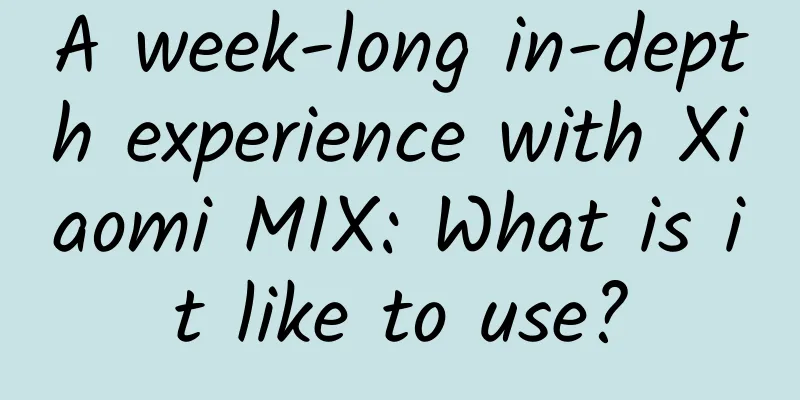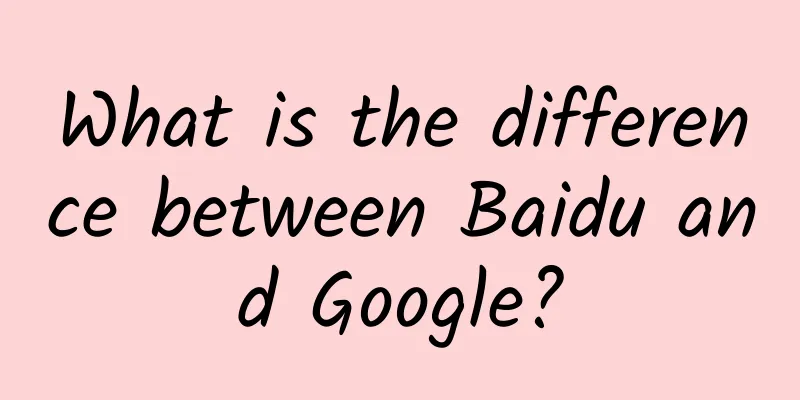A week-long in-depth experience with Xiaomi MIX: What is it like to use?

|
Since the first generation of Xiaomi mobile phones was released, words such as "ugly", "no design", and "no texture" have been associated with Xiaomi. It is true that Xiaomi puts most of its costs on hardware configuration, resulting in less cost for appearance and craftsmanship. But it is undeniable that Xiaomi, which has just entered the mobile phone field, is indeed a little lacking in appearance design capabilities. This situation has improved to a certain extent after the release of Xiaomi family-style products such as Xiaomi Note and Xiaomi 5, but it was not until the release of Xiaomi Note 2 and Xiaomi MIX concept phone last week that Xiaomi completely got rid of these labels. I believe everyone has read the review of Xiaomi Note 2. Overall, Xiaomi's progress in industrial design is indeed worthy of recognition. In terms of hardware configuration, Xiaomi Note 2 is also top-notch. The starting price of 2,799 yuan is still very reasonable, which is a good start for Xiaomi's high-end road. As for Xiaomi MIX, it is more like a product that Xiaomi demonstrates its industrial design capabilities. A 91.3% screen-to-body ratio plus a full ceramic shell are not something that any manufacturer can achieve. Even if they can, they may not have the courage to achieve it. Xiaomi has a pioneering spirit in its bones, and as time goes by, this pioneering spirit has gradually shifted from hardware configuration to industrial design. In fact, I got the Xiaomi MIX after the launch last week, but the review that should have been online a long time ago was delayed until today. Because we can't evaluate such a product with the usual eyes, after all, it still has the halo of a "concept phone". Therefore, in this review the author will abandon the previous stereotyped structure and mainly introduce this amazing concept machine from the perspective of user experience. 1. Sound In my opinion, for a mobile phone without an earpiece, many people should be concerned about how it makes sound. In fact, we have introduced this as early as when it was first released. It does not use the legendary bone conduction technology, but the cantilever beam piezoelectric ceramic vibration and then transmits the sound to the mobile phone frame. That is, the audio digital signal is converted into an analog signal, and then the ceramic frame is guided to resonate, and finally transmitted to the ear through sound waves. The advantages of doing so are obvious. Canceling the earpiece design not only saves space inside the phone, but also allows the top bezel of the phone to be directly removed (the front camera is moved to the bottom), easily achieving a "borderless" top. In addition, you don't need to put your ear to the receiver when answering a call (there is no receiver at all). As long as you are not facing the center of the screen, you can clearly hear the other party's voice at any position close to the frame of the device, and the sound volume at different positions is not much different. Of course, the disadvantages of this are also obvious. Since the sound is generated by the vibration of the middle frame, the palm of your hand can clearly feel the slight vibration of the phone when answering the call. It is fine in a noisy environment, but in a very quiet or crowded environment, people with better hearing around you can easily hear the content of your call, which is almost like turning on a speakerphone with a low volume, which is relatively embarrassing. If you value privacy through content, this is where headphones come in handy. As for the external speaker, you don't have to worry about it. Xiaomi MIX only removed the earpiece, and the speaker is still at the bottom of the phone. There is no difference in using it. 2. Feel How does it feel to use a product with a screen-to-body ratio of 91.3%? How is it different from ordinary mobile phones? First of all, it should be noted that although the screen size of Xiaomi MIX is as high as 6.4 inches, thanks to the ultra-high screen-to-body ratio, the actual size of the whole machine is not large, only 158.8*81.9*7.9mm. In comparison, the iPhone 7 Plus is 158.2*77.9*7.3mm, while the Mate 8 is 157.1*80.6*7.9mm. The actual sizes of the three phones are similar, but the screen sizes are very different, namely 6.4 inches, 5.5 inches and 6 inches respectively. However, in terms of weight, Xiaomi MIX's performance is relatively average. It weighs as much as 209g, which is obviously heavier than iPhone 7 Plus (188g) and Mate 8 (185g) when you hold it in your hand. So, in terms of overall feel, as long as you are used to ordinary 5.7-inch mobile phones, Xiaomi MIX will not feel big, and it is not difficult to operate with one hand. However, due to its high weight, it will inevitably be a bit uncomfortable after long-term use. In addition, it is not very convenient to play with the phone when lying in bed at night. In addition, since the Xiaomi MIX has a small curvature on the edge, users with small hands may feel a little uncomfortable when holding it. But if the palm is big enough, the ceramic feels pretty good. Finally, since the high-gloss ceramic shell is almost like a fingerprint collector and is very easy to break after falling, a case is almost the only option. Fortunately, Xiaomi officially included an original high-end protective case in the box, which feels quite good. In fact, this is not just a problem with Xiaomi MIX. Any ceramic/glass shell or bright black phone will be fragile or easily stained with fingerprints. Fortunately, the ceramic shell of Xiaomi MIX is relatively hard and the surface is not painted, so it will not have the annoying paint peeling or scratches of iPhone 7 Plus. At least after using it for a week, the screen has a little trace of use, but the back shell and frame are still perfect as new. 3. Screen In addition to the ultra-high screen-to-body ratio, the screen of Xiaomi MIX is also quite interesting. It uses a 17:9 customized screen from Sharp, and also abandons physical buttons to increase the screen-to-body ratio, using virtual buttons on the screen. This is the first Xiaomi phone to use virtual buttons. First, let's take a look at the screen parameters. Its resolution is 2040*1080, which is 120 pixels longer than the ordinary 1080p screen. These 120 pixels happen to be the area occupied by the virtual buttons. Therefore, the actual content displayed on the screen is still 16:9, which will not cause visual stretching or compression. In addition, the screen provided by Sharp has a ppi of 362, which still meets the retina screen standard, so there is no need to worry about graininess in actual use (after all, it is not an OLED screen). Although the contrast ratio of 1300:1, the maximum brightness of 500nit, and the NTSC color gamut of 94% are not top-level, they are definitely not outdated and are at the upper-middle level. Now let’s talk about the screen experience. It is undeniable that accidental touches are inevitable for products with ultra-narrow bezels, even if they have the same R&D capabilities as Apple or Samsung. In about a week of actual use, the Xiaomi MIX screen edge did have accidental touches, but the frequency was not high and did not affect the user experience. Overall it was within an acceptable range. However, MIUI's optimization for large screens really needs to be complained about. Since the default input method does not have a send button, after typing in a WeChat chat, you have to use your fingers to look for the send button that comes with WeChat. For such a large-screen mobile phone, it is really inconvenient. The grip is lower, which makes typing easier, but you can't touch the send button. The grip is higher, and you can touch the send button, but typing is painful. This is really not right for MIUI, which has been developed for so many years. At least, MIUI should come up with a version optimized for large screens, otherwise it will be very uncomfortable to operate. Of course, MIUI is worthy of recognition in terms of functionality. We have already introduced many new features of MIUI 8, and we will not list them one by one here. I will only talk about two aspects. --It's a waste not to have a split-screen function for such a large screen. Although not every user can use it, who doesn't want to watch a movie while chatting on WeChat? At least there is no need to switch back and forth. --As of now, MIUI still does not support WeChat fingerprint payment. Fortunately, Alipay has added the fingerprint payment function. I hope MIUI can get WeChat fingerprint payment working as soon as possible. Speaking of fingerprints, we have to mention the fingerprint recognition of Xiaomi MIX. Although it is a rear fingerprint and not a high-end ultrasonic one, the position of the rear fingerprint module is not too high, so fingerprint unlocking can be easily done with one hand, and there is nothing to get used to.
As for the virtual buttons, you can easily call out/hide the virtual buttons by swiping up or down, which is very convenient overall. If you have transitioned from a mobile phone with virtual buttons before, it will be easy to use. But if you are used to Xiaomi's previous physical button design, the virtual buttons will still take some time to get used to.
In addition, MIUI 8 provides a floating ball function, which can actually realize all the functions of the virtual buttons. If you are used to using the floating ball, you don’t need to call out the virtual buttons at all. Finally, let me talk about one advantage of the 17:9 screen. Since the screen is a little longer, you can actually get a better field of vision when navigating in landscape mode or playing games, which is very powerful. 4. Take photos At the press conference, Lei Jun did not make a big deal about the camera of Xiaomi MIX, and the actual situation is actually the same. Previously, we have confirmed the model of Xiaomi MIX camera, and its front and rear cameras are both from OV. Specifically, the front camera model is ov5675, with a pixel size of 1.12μm. It has no special functions and is finally packaged by Primax Technology, which should have reduced the package size. The specific model of the rear camera is ov16880, with 16 million effective pixels, a sensor size of 1/3.06 inches, and a pixel size of 1.0μm. Judging from the parameters, there is nothing outstanding about the front and rear cameras of Xiaomi MIX. However, the overall quality of mobile phone cameras has been qualitatively improved in the past two years. Therefore, even though Xiaomi MIX does not use top-level sensors this time, the quality of the photos taken is not bad, it’s just not that outstanding. However, for the target audience, the Xiaomi MIX's photography performance is actually good enough. If you have high requirements for photography, you can consider the Xiaomi 5S, and if you have high requirements for resolution, you can consider the Xiaomi Note 2. If you have high requirements for appearance, you can only consider the Xiaomi MIX. In short, for a product like Xiaomi MIX that focuses on stunning appearance, as long as the photography level is around the average, it is considered a success. In order to take into account the coordination of the overall design, Xiaomi MIX cannot use a sensor of too large a size... 5. Charging and battery life Due to its large size, the battery capacity of Xiaomi MIX is also powerful enough, reaching 4400mAh. The official standard is a QC 3.0 charging head that supports up to 18W fast charging. In the past two years, Xiaomi's performance in fast charging cannot be said to be unsatisfactory, nor is it outstanding. It can only be said to be a relatively stable development. It uses Qualcomm's public version QC2.0 (Xiaomi 4) and QC 3.0 (Xiaomi 5, Xiaomi Note 2, Xiaomi MIX) solutions. Compared with other manufacturers' 24W fast charging, Xiaomi's 18W is not outstanding, but it is actually enough, at least much faster than 5V/2A. In actual tests, it took Xiaomi MIX about two hours to charge from 0% to 100% using the original charger, but if it was only charged to 80%, it would only take a little more than an hour. The final trickle charging by Xiaomi was more conservative and took more time. In terms of battery life, Xiaomi Mi MIX is not very power-efficient due to its configuration. With a 4400mAh battery, it can last for a day under normal use. If it is used lightly, two days is not a big problem. 6. Is there any plagiarism? Ever since the release of Xiaomi MIX, people have been spreading the claim that it copied Sharp Aquos Crystal. Even the Xiaomi forum was filled with words related to Sharp at some point in time. First of all, from the appearance point of view, Xiaomi MIX and Sharp Aquos Crystal do adopt similar design styles, but if this alone is enough to call them plagiarism, then it would not be difficult to find a "father" for the best-selling products of the two international manufacturers and some domestic business flagships. Secondly, although both have a high screen-to-body ratio and borderless design, the design concept of Xiaomi MIX is different from that of Sharp Aquos Crystal. The latter moved the camera, sensors, etc. to the bottom of the screen, resulting in a particularly wide chin, while Xiaomi MIX simply placed the camera at the bottom, the distance sensor is implemented in the form of ultrasound, and the light sensor is hidden under the screen. As we all know, in a mobile phone where every inch of space is valuable, a change in the position of a sensor may lead to a redesign of the motherboard layout. Therefore, the interior of Xiaomi MIX is completely different from that of Sharp, which requires independent research and development capabilities. As for the appearance, the appearance of Xiaomi MIX was designed by the industrial design master Philippe Starck. In the design world, Philippe Starck is almost known to everyone. He is a legend in the design world. He is known as the "design genius", "design genius", "design king", and one of the most prestigious designers in the design world. In his decades of career, Philippe Starck has won numerous awards, including the Red Dot Design Award, IF Design Award, Harvard Excellence in Design Award and other international awards. So, there is really no need to say more about the conclusion. Summarize: As a concept phone, it is difficult for us to give Xiaomi MIX an accurate positioning. Its target users are enthusiasts who pursue new technologies and new features, or wealthy people who like to try new things. Due to the limited production capacity of ceramic shells, Xiaomi MIX will not have too much supply in the short term, and Xiaomi may not mass-produce it in the long run. Therefore, Xiaomi MIX is destined to be a very rare product and is destined to be very popular. If Xiaomi Note 2 is a good start for Xiaomi's high-end road, then Xiaomi MIX may be a product that consolidates the foundation of Xiaomi's high-end brand. If Xiaomi MIX can gain a foothold in the hands of high-end users, it will be of great help to improve Xiaomi's brand image. But the ice is three feet thick and it didn’t freeze overnight. If Xiaomi wants to truly cover the high-end product line, it cannot be done with just one or two products. It requires more time to accumulate. Finally, let's talk about Xiaomi MIX. Obviously, we can't describe such a concept phone as cost-effective, but for now, you obviously can't buy a product that beats Xiaomi MIX in appearance for more than 3,000 yuan. If you are a user who buys phones based on appearance, feel free to buy it. On the other hand, it is not easy to buy such a configuration for 3,999 yuan. But if you are looking for the user experience, I'm sorry, this concept phone cannot give you a very good experience. Xiaomi Note 2 may be more suitable for you. As a winner of Toutiao's Qingyun Plan and Baijiahao's Bai+ Plan, the 2019 Baidu Digital Author of the Year, the Baijiahao's Most Popular Author in the Technology Field, the 2019 Sogou Technology and Culture Author, and the 2021 Baijiahao Quarterly Influential Creator, he has won many awards, including the 2013 Sohu Best Industry Media Person, the 2015 China New Media Entrepreneurship Competition Beijing Third Place, the 2015 Guangmang Experience Award, the 2015 China New Media Entrepreneurship Competition Finals Third Place, and the 2018 Baidu Dynamic Annual Powerful Celebrity. |
Recommend
3 strategies for marketing growth in 2020!
Growth is a double-edged sword. It can solve many...
How to attract fans through WeChat and how to attract fans through WeChat activities?
WeChat, a social software owned by Tencent, has b...
iOS 7.1 reveals another fatal bug
The current vulnerability in iOS 7.1.1 not only in...
Experience 360 Video: A small but comprehensive video content platform
"360 Video has launched an APP, and all the c...
Keep user operation system
In the past two years, because of the epidemic, e...
Is the mathematical foundation of deep neural networks too difficult for you?
Deep Feedforward Network We start from statistics...
A beginner's guide to stock trading
A beginner's guide to stock trading 01-How to...
Microsoft's high-tech HoloLens: Will it take over AR after VR?
The three-day E3 gaming expo in the United States ...
What kind of virus is polio and what impact does it have on humans?
Recently, polio virus (commonly known as polio) a...
Weekly crooked review | IT circles are full of scheming! Qiangdong welcomes a child, and Jack Ma gives another gift
What is a crooked review? If it is not right, it ...
Professional Editor - Master Class
Professional Editor-Master Class Xuelang Resource...
Tencent practical case! How does QQ Sports upgrade user experience?
In this era of national fitness, more and more us...
Save the "disappeared her" in your mind! Can protein modification help you "remember"?
◎Reporter Zhang Jiaxin Improving memory is an ete...
8 KOL Marketing Trends Predictions for 2019!
There is a proverb in English, "There is no ...
A list of the weirdest rhinos that have ever appeared, with Fantastic Beasts and Where to Find Them topping the list
Today, this ancient species of rhino is facing th...









